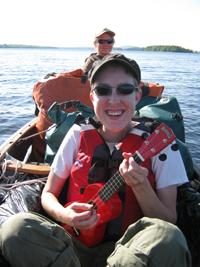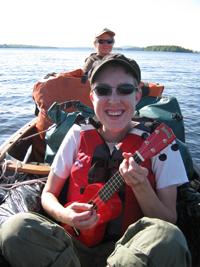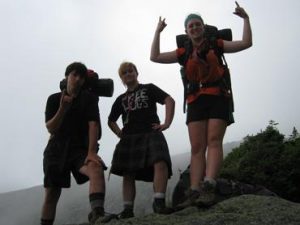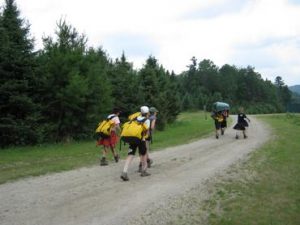“I think we should decide this by consensus,” Albert declares, running a hand through his wild uncombed curls. Eight teens and two adult guides are circled up on a flat spot on this steep mountain trail in New Hampshire. Our bulky backpacks are lined up on the side of the trail, and everyone is sipping water from their colorful Nalgene bottles.
“Okay, who’s going to facilitate?” Eric asks.
“I will! Let me get out some paper to keep stack,” Rita volunteers. “What is the question again?” she asks, swatting at a mosquito that buzzes around her head.
“We need to decide whether we are stopping for the night at the campsite that’s closer, or pushing on to the one that’s still four miles away,” I remind her. “Our decision needs to fit with the Leave No Trace guidelines we have learned, so we have to stay at an established campsite.”
The group settles down on the ground and dives into the consensus process. Albert, ever the organized thinker, points out that the longer we hike today, the less distance we’ll have to cover tomorrow when we traverse the Presidential Ridge. Bobby grimaces at his words, rubs his sore calves, and reminds the group how nice it would be to stop early today and make a really nice dinner and play some games. Rita scribbles notes and stack lists on her writing pad, biting her tongue with concentration as she tries to keep up with the lively discussion.
This group knows each other well: we have just finished a nine-day canoe trip in Maine and this is our first day on the backpacking section of this wilderness trip. As in any community, there is a wide diversity of strengths, weaknesses, and personal styles among these teenagers. Some are very fit and eager for a challenge, others are out of shape and want to drag their feet. Some think of the group first, others feel a need to prioritize their own needs. I’m lucky to work as an expedition guide for Farm & Wilderness Summer Camp, a Quaker-based camp that already embraces many of the principles of consensus in its daily routine and culture. On this trip my co-leader (who was trained in Formal Consensus in the student co-ops at Oberlin College) has taught a simple consensus decision-making process to our trip group. She and I have facilitated it for them twice before, but this is the first time the campers have done the whole thing on their own.
The discussion grows and weaves in the dappled shade of the mountain birches. Finally Rita announces a series of proposals and the campers all vote. Three pass, and a new discussion blooms about how to best combine them into one decision. The end result is a complex and nuanced negotiated agreement that involves dinner recipes, the time we get up in the morning, who has to retrieve the bear-hang food stash for breakfast the next day, and promises to play a round of the game Mafia on top of Mount Washington when we get there. I never would have guessed all these things were pertinent to a decision about where to camp for the night, but the glow on the teens’ faces show me that they were. They are all relieved to have navigated the consensus process successfully, and they shoulder their backpacks with an enthusiasm and determination that never would have surfaced if I’d made the decision for them.
I’ve been leading wilderness trips professionally for eight years, and following the intentional communities movement for 12 years. While I find that many wilderness guides I’ve worked with don’t know what an intentional community is, the culture of the outdoor education industry embraces many of the same guiding principles as communitarians do. A wilderness trip group is its own community, albeit a temporary one. Each trip has a different synthesis of individual personalities, so wilderness guides have to learn to set up community structures and norms that will accommodate whoever shows up. Unlike most residential communities, we can’t screen out members of our trip community based on emotional maturity or willingness to compromise. Whoever pays the trip fee will come on the trip. Therefore, most wilderness guides who last more than a year or two in the profession are those who learn to nurture harmony and cooperation amidst the many kinds of diversity they find on their trips. We use many of the same strategies residential communities do: creating shared agreements, rotation of leadership, fostering trust, sharing emotions honestly, and mediating conflict.
I have found that many kids take to this like a fish to water. After they are taught the skills and see them modeled a few times, they start initiating these techniques themselves. In the opening scene of this article, the teens themselves decided they could use consensus to make the decision. Having seen it work well twice before, they suggested it immediately when the conversation about campsites began to feel tense. Kids instinctively recognize healthy cultural norms when they experience them, and they naturally gravitate toward them. While many adults come to this work with emotional scars and triggers from the past trauma of living in a hierarchical power-over culture, kids have less emotional armor and an incredible willingness to try new things. The level of functional community that a group of teens from diverse backgrounds can create on a 15-day wilderness trip rivals that of any intentional community I’ve visited. The number of lifetime friendships that are forged on my trips attests to the staying power of positive group culture.
So, let’s learn from the youth! Below is a list of some of the group-building activities and conflict management strategies I use on my wilderness trips. All of these are teen-approved and have worked well to foster a community culture among the youth I work with. Most of them are common activities that are used widely across the outdoor education industry.
● The Group Agreement: The night before the trip starts, the group gathers together and brainstorms guidelines, behaviors, attitudes, and norms that they would like the group to strive for on the trip (always phrased in the positive). The agreements typically include respectful communication, positive attitude, following safety guidelines, using forest-friendly Leave No Trace practices, etc. We talk about what these statements mean to each person, discuss and clarify any controversial ones, and, once everyone can agree, we all sign the agreement. We carry this agreement with us on the trip and refer to it whenever conflict arises. In essence, this is a simplified version of the agreements and bylaws most intentional communities create for themselves.
● Fears in a Hat: On the first night of the trip, we sit in a circle. Each person writes down three fears they have about the trip and we put all the anonymous slips of paper in a hat. We each draw out someone else’s fears and read them aloud. Typically many people share common fears, so hearing that others have the same worries eases their minds. This also helps group members take actions to prevent triggering other group members’ fears: if three people said they are afraid they won’t be able to keep up, the speed demons in the group may be inspired to self-regulate their pace (and the guide can remind them of the fears when addressing impatience).
● Truth Circle: In the evening we sit in a circle, speak a self-reflective question or prompt, and then pass a talking stick. Each person may talk for as long as they like with no interruption. The talking stick goes around the circle again and again until no one has anything else they’d like to say. In this way we learn how others think about themselves and have a space to speak vulnerably in a safe and predictable environment.
● Evaluation Circles: Every few days we circle up and each person answers two questions: What do you think the group is doing well? What do you think could be improved? We speak our answers and promptly move on to the next activity. This activity fosters awareness of group dynamics and how behaviors are affecting others, while also asking each person to think about what is working for the group, not just what is working for themselves. The evaluation circle acts as a self-correction mechanism for the group: usually everyone takes action to improve dysfunctional dynamics that have been spoken in the circle, without any discussion or nagging.
● Leader of the Day: Every day a different camper leads the group. They carry the map and compass, they decide when we have rest breaks and where we have lunch. This mirrors the systems of non-hierarchical leadership that inspire many intentional communities to rotate their leadership roles.
● Silent Meeting: When working for Farm & Wilderness, a Quaker-based camp, we have a daily 20 minute gathering to sit in silence together in a beautiful spot. This shared reflection time allows our spiritual selves to be honored in the same place without any layers of dogma. I find that the shared silence brings the spirits of all the trip participants into a quiet harmony once a day, gives us a break from any conflict that may be present, and fosters an attitude of gratitude. Many spiritual New Age communities open their meetings with a period of shared silence for the same reason.
I hope these activities will inspire readers to try some new strategies for keeping their own communities cooperative and dynamic, and offer kids who don’t live in community a way to learn about cooperative culture: go take a hike with a wilderness guide!





















